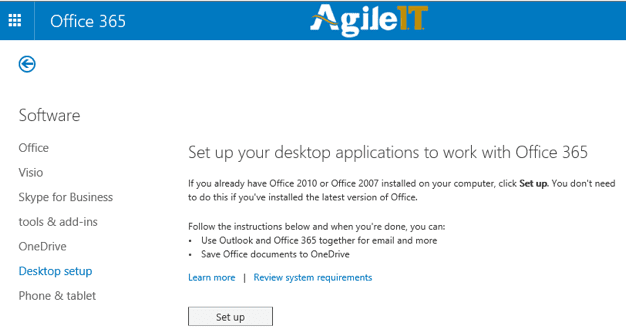For an updated version of this guide, please visit: our Office 365 Workstation Setup and End User Workstation Configuration Guide
Office 365 setup for user workstations involves installing and configuring Office 365 applications and the associated licenses. With the help of autodiscover, the process is fairly simple. But when autodiscover isn’t working or available (such as before a migration), you’ll need to do a manual Office 365 workstation setup.
In this post, we’ll guide you through the step-by-step setup process based on your license type.
Are you fully optimizing Office 365? Learn about Agile IT’s award-winning Office 365 consulting services or contact us today to help bridge your technology and business goals.
Your Guide to Manual Office 365 Workstation Setup
Before moving forward with a manual setup, you need to know what you’re working with. The process will differ depending on whether the user has an E1 or E3 license.
- E3 and Business Premium license holders: Confirm you will be installing Office 2016 to your computer. Follow the instructions for “E3” not “E1.”
- E1, Business Essentials, Email Only license holders or those not installing Office 2016 to your computer: Follow the instructions for “E1” not “E3.”
Here’s the road map for setting up PC desktops for Office 365 (click below to jump to any section on the page):
- Your Guide to Manual Office 365 Workstation Setup
Setting Up Your Desktop for Office 365
Ready to get started setting up your Office 365 desktops? First, sign in to the Office 365 portal (portal.office365.com). Then follow these steps:
Check for and Remove Incompatible Software
Incompatible software will interfere with the Office 365 setup. To remove incompatible software, follow these steps:
-
- ABBYY FineReader – uninstall
-
DisplayLink Core – upgrade to version 7.1 M or latest
Note: If Office is freezing after installing the new Office, try these tips:
- Disable “hardware graphics acceleration” (under Options from any Office program).
- Change default printer (some printer drovers may need to be updated.)
Remove Old Office Versions
For E3 licenses: If you have an older version of Microsoft Office already installed, you will first need to completely uninstall it before installing Office 2016 Pro Plus. Open your Control Panel and the Programs folder. Locate Microsoft Office, and select Uninstall. You’ll also need to reboot.
Run and Install All Available Microsoft Updates
This step is required for all configurations, and users may need to reboot once installed.
For E3 licenses: Install the New Office 2016
Here’s how to install the new Office 2016 to your PC:
- Sign in to the Office 365 portal (portal.office365.com).
- Click on the Gear icon in the upper right corner of the screen, then select Office 365 Settings.

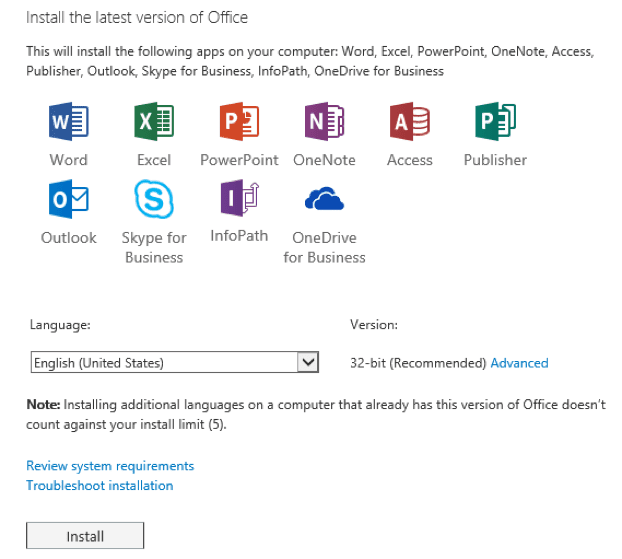
- You will be installing Office 2016 Pro Plus to your PC. You can do so by clicking Install displayed under the header.
This will begin streaming the software to the computer. After the “Click to Run” process begins, you will be able to launch the applications and have them ready for use. Meanwhile, the rest of the components will download, update and install in the background. “Click to Run” can take several hours to fully complete. You can read more on the “Click to Run” technology here.
NOTE: If an older version of Microsoft Office is already installed, you need to completely uninstall it before installing Office 2016 Pro Plus.
For E1 Licenses: Install Desktop Update and Skype for Business
Note: Office 2007 is no longer a supported version of Office. You may need to update to Office 2016. To install Skype for Business, follow these instructions:
- If your Office 2016 does not contain Skype for Business (formerly Lync) or you’re using Office 2007 or 2010 on this computer, you can still install the Skype for Business client from the Office 365 list of Software. Simply click the Skype for Business icon. After the Skype for Business App has been installed along with your older version of Office (2007 or 2010), see step 2 to run Desktop Setup.

- If your version of Office is Office 2010 SP2 or later, it’s ready to connect to Office 365, and you should skip this step for Desktop Setup.
Prompts and Processing Actions
- If prompted, sign in using your Microsoft Online Services ID (your email address).
- The Office 365 desktop setup will check your system configuration. When the check completes without detecting any problems, you’ll be presented with options to configure your desktop applications and a link to learn more about the important updates Office 365 desktop setup will install.
A message will appear if the software detects a problem. Refer to Troubleshoot update and configuration issues for Office 365 for information to resolve the issue.
- After you’ve selected the applications you want to configure, click Continue, review the service agreements then click “I Accept” to begin installing updates and configuring desktop applications.
Important Some applications may have shaded checkboxes if your account isn’t provisioned to use this application with Office 365 or if your computer doesn’t have the required applications already installed.
When the installation and configuration have completed, you may have to restart your computer to finalize the installation and configuration processes.
After running Office 365 desktop setup, a shortcut to the Office 365 portal will be added to the Start menu on your desktop.
- When configuring Office 365 with a preinstalled copy of Office already on a machine, you may see a warning during the configuration of Outlook requiring additional manual steps. In this case, start up the Outlook program and complete the wizard, which will use auto-detect to configure the profile, based on this user’s Active Directory login. Based on the email address you supply to the setup wizard, a link will appear to Learn More in the Setup Wizard. This will take you to a list of help articles, which detail how to complete the manual steps for setting up Outlook.
Office 365 Outlook Manual Settings
When Autodiscover isn’t working, you can’t complete the Outlook setup and/or have your credentials recognized. You can configure a mail profile to connect to Office 365 by pointing the profile to the servers manually. To find the correct server information, follow these steps:
Note: After setting up Outlook, please allow at least an hour for Outlook to fully synchronize with Office 365. The process will be complete when the status bar in Outlook displays “All folders up to date” for more than 3 minutes.
Adding Office 365 to your Outlook 2016 desktop application
- To open Outlook:
- Windows 7: On the Start menu, point to Control Panel, and then click Mail.
- Windows 8: On the start menu, type point to Control Panel, and then click Mail.
- In the Mail Setup dialog box, select Show Profiles.
- Then click Add in the Mail dialog box.
- In the New Profile dialog box, type a new profile name (e.g., Office 365) then select OK.
- Select the Manual Configuration option in the Add New Account dialog box. Then select Next.

- Select “Microsoft Exchange Server” or “Compatible Service” and click “Next.” In the field labeled “Server,” supply the information: outlook.office365.com. Add the full Office 365 email address in the User Name field. Then click the More Settings button.
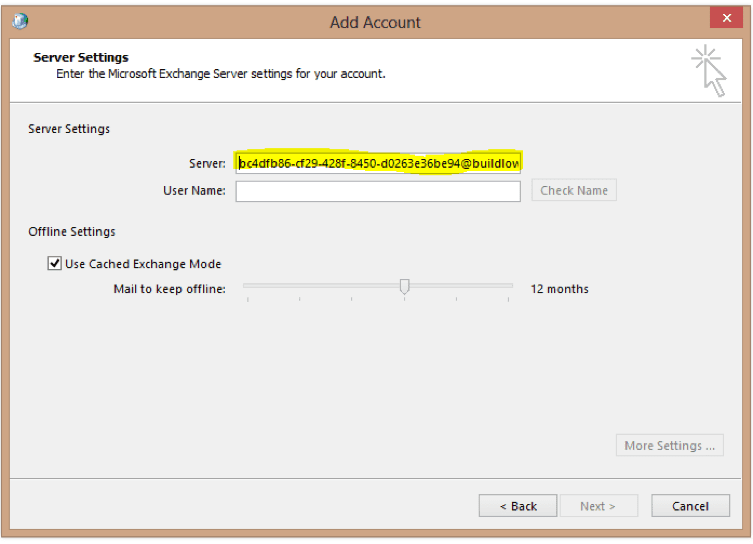
- Now select the Security tab, then uncheck the boxes under “Encryption.” Under Logon Network Security, choose Anonymous Authentication from the drop-down list.
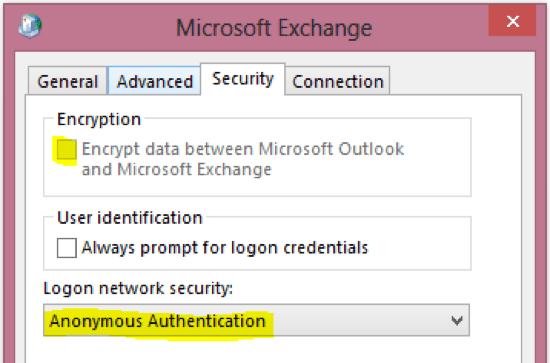
- Select the Connection tab, check the box Connect to Microsoft Exchange using HTTP and click on the Exchange Proxy Settings Button.
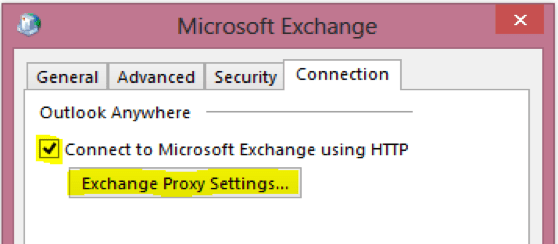
- In the Connection Settings field, type “outlook.office365.com.” Check the box next to “Only connect to proxy servers that have this principal name in their certificate.” In the field below, type “msstd.com.” Check the box next to “On fast network, connect using HTTP first, then connect using TCP/IP.” Under Proxy Authentication settings, select “Basic Authentication” from the drop-down menu.
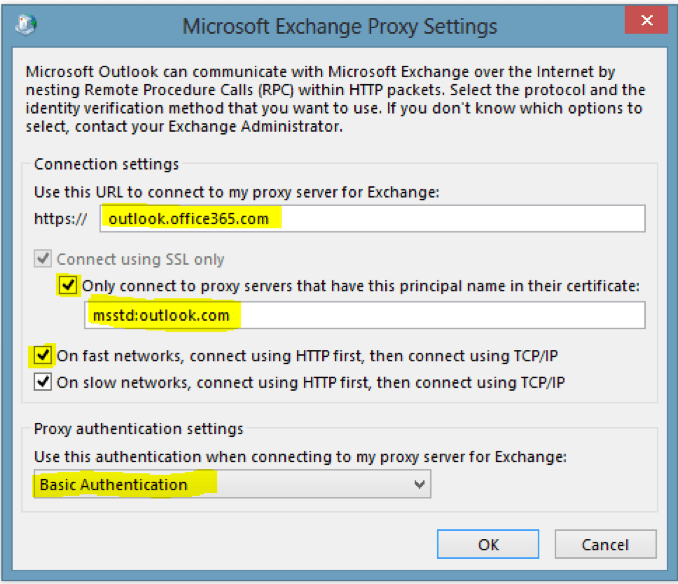
- Click OK.
- Select Check name then Enter your Office 365 user email address (address should underline). Click OK.
- If prompted for credentials, enter your email address and password for Office 365.
- At the Add New Account - Congratulations dialog box, select Finish.
- You will return to the Mail dialog box. Set “Always use this profile” to match your newly created mail profile, then select OK.
- Now, start Outlook from your Start Menu. The new profile will open and begin to synchronize with Office 365 online mailbox. Note: This operation can take an hour or more per GB of mailbox size.
Skype for Business Manual Setup
If the Skype for Business client won’t sign in after installation and isn’t requiring a software download, you’ll need to manually specify the server.
Note: Either the Lync or Skype for Business client interface may be displayed. They are functionally the same.
Use the following steps to manually specify the Skype for Business server:
- Open the Options menu by clicking on the Gear icon in the upper right of the Skype for Business window.
- Next click on the “Advanced” button next to your Sign-in address.
 Select the Manual Configuration option and supply the “sipdir.online.lync.com:443” as both the Internal and External server names. This is the universal address for all Office 365 Skype for Business users. The address will only be different if your Skype for Business service is not hosted on Office 365 (e.g., different service or on-premises server).
Select the Manual Configuration option and supply the “sipdir.online.lync.com:443” as both the Internal and External server names. This is the universal address for all Office 365 Skype for Business users. The address will only be different if your Skype for Business service is not hosted on Office 365 (e.g., different service or on-premises server). 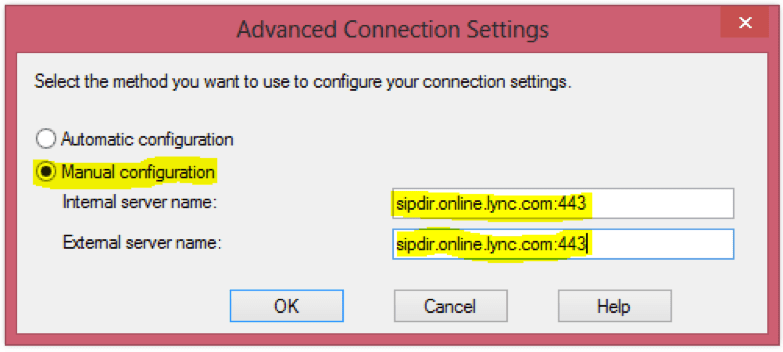 To complete the Skype setup, confirm your way out of the “Options” (click OK until you’re back at the Sign-in Screen for Skype). Your Skype for Business client should connect successfully.
To complete the Skype setup, confirm your way out of the “Options” (click OK until you’re back at the Sign-in Screen for Skype). Your Skype for Business client should connect successfully.
Are you fully optimizing Office 365? Managing your cloud environment requires an entirely new skill set. Learn about Agile IT’s award-winning Office 365 consulting services or contact us today to help bridge your technology and business goals.
Published on: .
